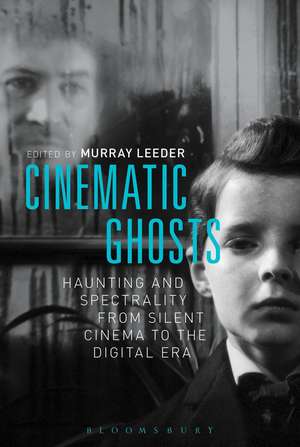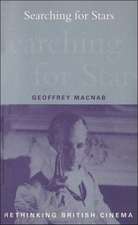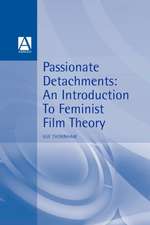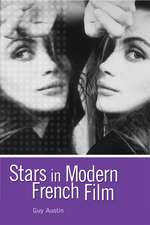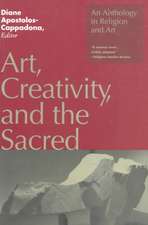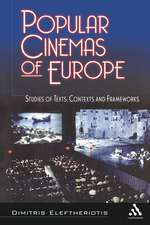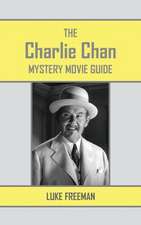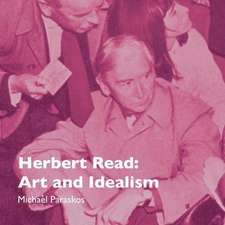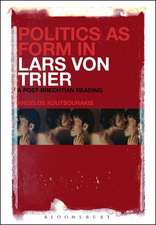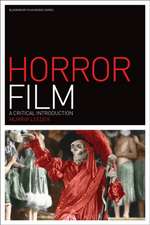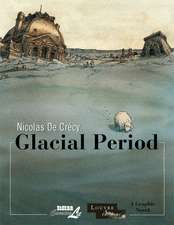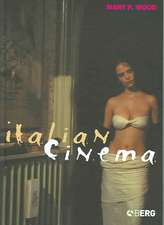Cinematic Ghosts: Haunting and Spectrality from Silent Cinema to the Digital Era
Editat de Murray Leederen Limba Engleză Paperback – 9 sep 2015
| Toate formatele și edițiile | Preț | Express |
|---|---|---|
| Paperback (1) | 194.06 lei 6-8 săpt. | |
| Bloomsbury Publishing – 9 sep 2015 | 194.06 lei 6-8 săpt. | |
| Hardback (1) | 835.51 lei 6-8 săpt. | |
| Bloomsbury Publishing – 9 sep 2015 | 835.51 lei 6-8 săpt. |
Preț: 194.06 lei
Preț vechi: 224.24 lei
-13% Nou
Puncte Express: 291
Preț estimativ în valută:
37.14€ • 38.63$ • 30.66£
37.14€ • 38.63$ • 30.66£
Carte tipărită la comandă
Livrare economică 14-28 aprilie
Preluare comenzi: 021 569.72.76
Specificații
ISBN-13: 9781628922134
ISBN-10: 1628922133
Pagini: 320
Ilustrații: 30 bw illus
Dimensiuni: 152 x 229 x 23 mm
Greutate: 0.48 kg
Editura: Bloomsbury Publishing
Colecția Bloomsbury Academic
Locul publicării:New York, United States
ISBN-10: 1628922133
Pagini: 320
Ilustrații: 30 bw illus
Dimensiuni: 152 x 229 x 23 mm
Greutate: 0.48 kg
Editura: Bloomsbury Publishing
Colecția Bloomsbury Academic
Locul publicării:New York, United States
Caracteristici
Includes many top scholars in the field: Tom Gunning, Jeffrey Sconce, Mitsuyo Wada-Marciano, Mark Jancovich, Katherine A. Fowkes, and Bernice Murphy
Notă biografică
Murray Leeder is Adjunct Assistant Professor in Communication, Media and Film at the University of Calgary, Canada. He is the author The Modern Supernatural and the Beginnings of Cinema (2017) and Halloween (2013), and editor of Cinematic Ghosts (2015) and ReFocus: The Films of William Castle (2018).
Cuprins
Acknowledgements IntroductionMurray Leeder, University of Calgary, CanadaGhosts of Pre-Cinema and Silent CinemaChapter 1Phantom Images and Modern Manifestations: Spirit Photography, Magic Theater, Trick Films and Photography's UncannyTom Gunning, University of Chicago, USA Chapter 2"Visualizing the Phantoms of the Imagination": Projecting Haunted Minds Murray Leeder, University of Calgary, Canada Chapter 3Specters of the Mind: Ghosts, Illusion, and Exposure in Paul Leni's The Cat and the CanarySimone Natale, Humboldt University, Germany Chapter 4Supernatural Speech: Silent Cinema's Stake in Visualizing the Impossible Robert Alford, University of California, Berkeley, USA Cinematic Ghosts from the 1940s through the 1980sChapter 5Bad Sync: Spectral Sound and Retro-effects in Portrait of Jennie René Thoreau Bruckner, University of Southern California, USA Chapter 6"Antique Chiller": Quality, Pretention and History in the Critical Reception of The Innocents and The Haunting Mark Jancovich, University of East Anglia, UK Chapter 7Shadows of Shadows: The Undead in Ingmar Bergman's Cinema Maurizio Cinquegrani, University of Kent, UK Chapter 8Locating the Spectre in Dan Curtis's Burnt Offerings Dara Downey, University College Dublin, Ireland Chapter 9The Bawdy Body in Two Comedy Ghost Films: Topper and Beetlejuice Katherine A. Fowkes, High Point University, USA Millennial GhostsChapter 10"I See Dead People": Visualizing Ghosts in the Horror Film Before the Arrival of CGI Steffen Hantke, Sogang University, KoreaChapter 11Spectral Remainders and Transcultural Hauntings: (Re)iterations of the Onryo in ContemporaryJapanese Horror Cinema Jay McRoy, University of Wisconsin - Parkside, USA Chapter 12Painted Skin: Romance with the Ghostly Femme Fatale in Contemporary Chinese Cinema Li Zeng, Illinois State University, USA Chapter 13"It's Not the House that's Haunted": Demons, Debt and the Family in Peril in Recent Horror CinemaBernice M. Murphy, Trinity College, Dublin, Ireland Chapter 14Glitch Gothic Marc Olivier, Brigham Young University, USA Chapter 15Showing the Unknown: Uncle Boonmee Who Can Recall His Past Lives Mitsuyo Wada-Marciano, Carleton University, Canada Afterword: Haunted Viewers Jeffrey Sconce, Northwestern University, USA
Recenzii
There is much to interest readers and the book will (dare I say it) leave them in good spirits ... A thoughtful and entertaining addition to any film or religion studies collection, whether for personal or professional purposes, at undergraduate or postgraduate level.
The stand out feature of this collection is the diagnostic links between the content of ghost films and the ghostly techniques through which they are shot, a level of connection that puts Leeder's text a step ahead of other purely thematic approaches to ghosts and haunted cinema. Cinematic Ghosts is just as much about ghostly cinematics, adding appeal to scholars of film production and spectral narratives alike.
Cinema has always been a ghostly medium. Now we finally have a book that explores film's relation to ghosts with the breadth and depth it deserves, moving deftly across historical periods, genre classifications, and national origins. This is a rich and varied collection that will haunt - in all the right ways - a broad range of readers, scholars, and students.
Ghosts have haunted film from its earliest years to the present day, as this volume admirably demonstrates. It is impressive for its chronological and geographical range, and for the consistent quality of the contributions. Breaking new ground in exploring the interlinked theoretical, cultural and national stakes of cinematic haunting, this invaluable collection is certain to be a standard reference point for all future work in the field.
Murray Leeder's strongly focused collection adds another exhilarating twist to the spectral turn by providing a welcome opportunity to reflect on the enduring notion of cinema as a haunted/haunting medium. Asking where non-figurative cinematic ghosts have been and where they might be going, a series of engaging contributions systematically charts the changing narrative, visual and sonic modes of haunting from the silent era to the digital age. Throughout, Cinematic Ghosts shows great sensitivity to the ghost's cultural and historical specificity and, in terms of the films discussed, effectively-and fittingly-combines the expected with the unexpected.
Whether you've accepted a dare to spend one night in a haunted house or just have an interest in ghosts on the silver screen, Murray Leeder's Cinematic Ghosts is essential reading. Ranging from the origins of cinematic ghosts in nineteenth-century phantasmagoria to twenty-first century "glitch gothic," and from classic Western hauntings such as the The Innocents to the Asian onryo, this broad and engaging collection of essays--the first such collection specifically on cinematic ghosts--offers a lively, much-needed analysis of the history and appeal of movie phantoms. International in scope and historicist in approach, Cinematic Ghosts brilliantly showcases the depth and richness of supernatural film and will haunt all subsequent approaches to the topic. Ghostbusters, step aside. Murray Leeder is now the one to call if there's something strange in your neighborhood!
The stand out feature of this collection is the diagnostic links between the content of ghost films and the ghostly techniques through which they are shot, a level of connection that puts Leeder's text a step ahead of other purely thematic approaches to ghosts and haunted cinema. Cinematic Ghosts is just as much about ghostly cinematics, adding appeal to scholars of film production and spectral narratives alike.
Cinema has always been a ghostly medium. Now we finally have a book that explores film's relation to ghosts with the breadth and depth it deserves, moving deftly across historical periods, genre classifications, and national origins. This is a rich and varied collection that will haunt - in all the right ways - a broad range of readers, scholars, and students.
Ghosts have haunted film from its earliest years to the present day, as this volume admirably demonstrates. It is impressive for its chronological and geographical range, and for the consistent quality of the contributions. Breaking new ground in exploring the interlinked theoretical, cultural and national stakes of cinematic haunting, this invaluable collection is certain to be a standard reference point for all future work in the field.
Murray Leeder's strongly focused collection adds another exhilarating twist to the spectral turn by providing a welcome opportunity to reflect on the enduring notion of cinema as a haunted/haunting medium. Asking where non-figurative cinematic ghosts have been and where they might be going, a series of engaging contributions systematically charts the changing narrative, visual and sonic modes of haunting from the silent era to the digital age. Throughout, Cinematic Ghosts shows great sensitivity to the ghost's cultural and historical specificity and, in terms of the films discussed, effectively-and fittingly-combines the expected with the unexpected.
Whether you've accepted a dare to spend one night in a haunted house or just have an interest in ghosts on the silver screen, Murray Leeder's Cinematic Ghosts is essential reading. Ranging from the origins of cinematic ghosts in nineteenth-century phantasmagoria to twenty-first century "glitch gothic," and from classic Western hauntings such as the The Innocents to the Asian onryo, this broad and engaging collection of essays--the first such collection specifically on cinematic ghosts--offers a lively, much-needed analysis of the history and appeal of movie phantoms. International in scope and historicist in approach, Cinematic Ghosts brilliantly showcases the depth and richness of supernatural film and will haunt all subsequent approaches to the topic. Ghostbusters, step aside. Murray Leeder is now the one to call if there's something strange in your neighborhood!
